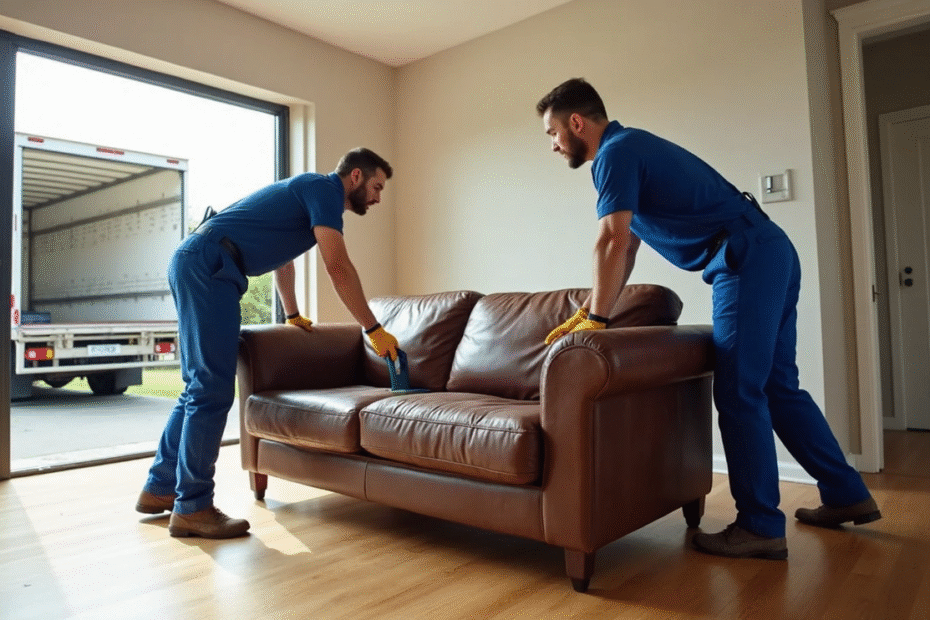Couch removal cost becomes important once you face that old sofa taking up space in your living room. Most homeowners need to deal with bulky furniture disposal during upgrades or moves, and the costs can surprise you. The average furniture removal cost in the U.S. reaches around $180, and prices typically range from $75 to $250.
A standard couch’s removal costs between $75 and $160. On top of that, it costs at least $75 to remove a sectional sofa through professional services. Our research into current market rates helps explain what you’ll pay to remove your couch. This piece breaks down every factor that affects your final cost, from basic sofas to large sectionals.
Average Couch Removal Cost in 2025
The cost of getting rid of old couches in 2025 isn’t as simple or cheap as most homeowners might think. You’ll need to understand current market rates to budget the right amount for this service.
Typical price range for couch removal
A standard couch removal costs between $75 to $160. The size and condition of your furniture affect these prices. You might pay between $80 and $200 to remove a couch and accent chair together. Sectional sofas start at $75 but usually cost more because they’re bigger and heavier.
Junk removal companies set minimum fees of $50 to $125 whatever the job size. The total cost can reach $100 to $350 if you need to get rid of multiple furniture pieces.
What influences the national average
The national average for furniture removal is about $180. Several factors can drive this price up or down. Location is a vital factor – removing a recliner in Jackson, Mississippi costs substantially less than in San Francisco, California.
Companies typically use volume-based pricing that depends on:
- Truck space utilization
- Item weight and size
- Accessibility challenges
- Travel distance to disposal sites
Homes with narrow hallways, multiple flights of stairs, or remote locations cost more for removal. Companies add charges for fuel costs and travel time to reach far-off places.
How pricing has changed over the years
Over the last several years, removal costs have gone up due to higher disposal fees and labor costs. The typical junk removal load in 2025 costs around $242. Most homeowners spend between $133 and $372.
The overall range for junk removal services has expanded to $75-$800. This reflects more specialized services in the industry. Stricter environmental rules, especially for items with potentially hazardous materials, have pushed prices higher.
The market offers more service options despite rising costs. Companies now give bundle discounts when you remove multiple items at once. This makes it cheaper to clear out several pieces together instead of scheduling separate pickups.

Cost Breakdown by Couch Type
Couch removal prices can vary a lot depending on what type you need to get rid of. These price differences will help you plan your budget better.
Standard sofa removal cost
A simple couch removal will cost you between $75 and $160. Junk removal companies set minimum fees from $75 to $125 whatever the size. A standard couch needs moderate truck space, which puts it in the mid-range price category. You can expect to pay around $80 as a starting price, but this changes based on your location and the company you choose.
Sectional or multi-piece couch
You’ll pay more for sectional sofas due to their size and complexity. A two-piece sectional typically costs $240 to $260, though some companies start at $80. In San Francisco, a two-piece sectional might cost around $179.55, which shows how your location affects the price. Companies don’t usually ask you to take apart sectionals before pickup, but they charge extra for this service.
Recliners and sleeper sofas
The weight and mechanical parts of sleeper sofas and recliners make them tricky to remove. Sleeper sofa removal starts at about $125. A recent job in Dallas that included a sleeper sofa, futon, and mattress cost $212.80. Getting rid of a recliner usually costs between $100 and $120. These prices put them above standard chairs but below complex sleeper sofas.
Luxury or oversized couches
Luxury and oversized couches are the most expensive to remove. Their weight, premium materials, and the challenge of moving them through doorways drive up the cost. Heavy or oversized pieces need extra time and effort, which adds to the final price. Let your junk removal company know about any large pieces ahead of time. This helps you get an accurate quote and avoid unexpected charges on removal day.
Key Factors That Affect Couch Removal Cost
You should know what affects couch removal prices to budget well and avoid unexpected costs. Several factors determine the final price you’ll pay to get rid of your old sofa.
Size and weight of the couch
Your couch’s physical dimensions are the biggest factor in removal costs. Moving larger and heavier furniture takes more effort, equipment, and time. Moving bulky sectionals safely needs more workers, which raises labor costs. Heavy pieces might also need specialized equipment like dollies, straps, or lifting tools—all of which add to your final bill.
Location and accessibility
Your couch’s location affects removal prices by a lot. Junk removal becomes much harder if your furniture sits in a tough spot—like a fifth-floor walkup or behind narrow hallways. Companies usually charge extra to carry furniture down multiple flights of stairs, especially in buildings without elevators. Making access easier before removal crews arrive can help cut your costs.
Removal method: DIY vs. professional
Your choice of removal method changes total costs dramatically. Local moving services give you labor, equipment, and proper disposal but cost more, ranging from $80-$200 for simple removal. DIY removal might look cheaper at first but comes with hidden costs:
- Vehicle damage risks (scratches, dents, tire punctures)
- Landfill fees ($10-$50 per large item)
- Possible injury costs from wrong lifting
- Extra trips that increase fuel costs
Distance to disposal or donation site
The distance to disposal facilities directly affects your bill. Longer distances use more fuel and time, especially if you need multiple trips. Short distances (1-5 miles) cost around $60, while 10-20 mile trips can reach $80. Professional services usually include transportation in their quotes but might charge extra for remote locations.
Time of year and demand
Seasonal patterns change pricing throughout the year. Costs often rise during peak moving seasons (spring and summer) because of high demand. Many companies set higher rates during these busy times when more people need removal services.
Extra labor or disassembly needs
Extra services like furniture disassembly or special handling raise costs. Taking apart large pieces like sectionals or tables adds time and labor expenses. Some companies charge by the hour for prep work, which includes disassembly, packing, or sorting items.
Smart Ways to Save on Sofa Removal
You just need a bit of smart planning to save money on couch removal. Smart planning can help you cut down those hefty removal fees we talked about earlier.
Compare quotes from multiple providers
The quickest way to find the best deal is getting multiple estimates. A good quote should spell out truck space needs, disposal methods, and any extra fees. Make sure you know about overage costs if you end up with more items when the team shows up. Getting 2-3 quotes helps you compare services and pricing effectively. Companies like Junk King even match prices, which can save you a lot of money.
Schedule during off-peak times
Smart timing can save you real money. Mid-week bookings cost less and give you better scheduling options than weekends and holidays. Removal companies see less business in winter months and often run seasonal deals. Stay away from summer and early fall since these peak moving seasons push prices up.
Disassemble the couch yourself
Taking your couch apart before removal saves space and cash. Your costs drop when you remove cushions, upholstery, and legs because they take up less space in the truck. Don’t worry about keeping the upholstery intact – you can just cut or rip it off. This prep work cuts down the space your items take up in removal trucks and lowers your final bill.
Use curbside pickup options
Removal services often charge less for curbside pickup. LoadUp takes $5 off when you place items at the curb. Many retailers include old furniture removal with their curbside services for new purchases.
Donate or sell usable furniture
A gently used couch can benefit both your wallet and the environment. Habitat for Humanity ReStores welcomes furniture donations and sometimes picks up large items free. These donations might qualify for tax deductions – just ask for a receipt. You could also turn that unwanted couch into cash by listing it on Facebook Marketplace or local sales sites.
Final Thoughts on Couch Removal Costs
Couch removal costs more than most homeowners expect at first. Standard sofa removal prices range from $75-$160. Sectionals and specialty pieces cost even more. Most junk removal companies also charge minimum fees of $50-$125, whatever the job size.
Your final bill depends on several key factors. The couch’s size and weight are the biggest cost drivers. Access challenges and your chosen removal method also affect the price. Understanding these elements helps you plan better financially and logistically.
You have several ways to cut down costs. Getting quotes from multiple providers ensures you get competitive prices. Scheduling your removal during slower seasons works better than peak summer months. You could also think over donation or resale options if your furniture is still usable.
Getting your couch ready before removal can substantially reduce volume-based charges. You might want to take it apart or just remove the cushions. DIY removal could be right for your situation. Professional services are a great way to get convenience and disposal guarantees.
Smart planning helps avoid surprise costs. The right timing and preparation often make the difference between paying minimum fees and premium rates. You can direct your couch removal project without hurting your budget if you know what to expect and how to save money.

